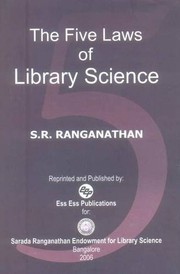Check nearby libraries
Buy this book

Ranganathan coined five "laws", as principles that still guide the operation of modern libraries:
1. Books are for use.
2. Books are for all.
3. Every book its reader.
4. Save the time of the reader.
5. The library is a growing organism.
Each of these is discussed in depth, with numerous examples drawn from library systems around the world, to establish the principles underlying the then-fledgling Indian library movement.
S. R. (Shiyali Ramamrita) Ranganathan, considered by librarians all over the world to be the father of modern library science, proposed five laws of library science in the early 1930s. Most librarians worldwide accept them as the foundations of the philosophy of their work and service in the library. These laws are: Books are for use, Every reader his or her book, Every book its reader, Save the time of the reader, and The library is a growing organism. The Five Laws of Library Science are some of the most influential concepts in the field. Since they were published in 1931, these five laws "have remained a centerpiece of professional values..." (Rubin 2004). These basic theories of Library Science continue to directly impact the development of this discipline and the service of all libraries. [From Wikipedia, the free encyclopedia]. The book has been reprinted over twenty-five times to meet the demand from libraries, students of library and information science and information professionals. In 2006 when DLIST (University of Arizona) placed a test version of the contents page and first chapter of the first edition of the book on the Internet, there were some 640 downloads in twenty-four hours. The "five laws" are equally valid in the present digital / information age as they have been in the conventional library environment.
Check nearby libraries
Buy this book

Previews available in: English
Subjects
Library science, Libraries, Library administrationShowing 1 featured edition. View all 12 editions?
| Edition | Availability |
|---|---|
|
1
The Five Laws of Library Science
August 18, 2006, Ess Ess Publications, Ess Ess Publications for Sarada Ranganathan Endowment for Library Science
Hardcover
in English
8170004985 9788170004981
|
aaaa
Libraries near you:
WorldCat
|
Book Details
Published in
New Delhi, India
Table of Contents
Edition Notes
Published for Sarada Ranganathan Endowment for Library Science, Bangalore, India.
The Physical Object
ID Numbers
Community Reviews (0)
Feedback?| July 11, 2021 | Edited by Drini | Rm wong IDs from a book about birds |
| July 11, 2021 | Edited by Drini | Merge works |
| July 11, 2021 | Edited by Drini | Edited without comment. |
| January 4, 2017 | Edited by LeadSongDog | Edited without comment. |
| October 27, 2009 | Created by WorkBot | add works page |









